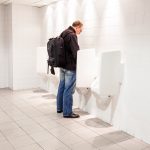 Millions of women suffer from urinary incontinence (UI), and while many people believe it is simply an age-related issue, it can, in fact, affect younger people, too. Noticing the symptoms early and identifying the cause can help women with urinary incontinence get back to enjoying life. (See: Common Incontinence Products)
Millions of women suffer from urinary incontinence (UI), and while many people believe it is simply an age-related issue, it can, in fact, affect younger people, too. Noticing the symptoms early and identifying the cause can help women with urinary incontinence get back to enjoying life. (See: Common Incontinence Products)
Urinary incontinence in women can be both physically and emotionally draining. Essentially, it is the leaking of urine that can’t be controlled. As a result, many women are afraid to leave the house out of fear they will be too far away from a washroom. Some people suffer in silence because they are too embarrassed to talk about it. The truth is, this condition can be managed and treated, so if you think you are experiencing urinary incontinence you should speak to a medical professional.
Advertisement
Some women lose a few drops of urine when they exercise or cough, others may feel a strong or sudden urge to urinate. In some cases, women can experience both. Urine loss is also possible during sexual activity, which can cause a lot of emotional stress.
Urinary incontinence is often related to the muscles and nerves that help hold or release urine. Obesity is linked to increased pressure on the abdominal muscles and can make incontinence worse. Weight loss can reduce the severity, but again it is important to see a doctor for a proper assessment.
Up to a third of women in the United States suffer from urinary incontinence. About 33 million have overactive bladder, or OAB, which means they feel urgency and/or frequency with or without urge incontinence.
Research shows that while urinary incontinence risk can be linked to aging, it can also be associated with pregnancy, delivery, and the number of children you have. It doesn’t matter whether you have a vaginal or C-section delivery, the risk is still the same. Studies also indicate that women can experience urinary incontinence after menopause due to the drop in estrogen, yet taking estrogen doesn’t seem to help those who suffer from urinary incontinence. As mentioned above, excess weight can also increase your risk of getting urinary incontinence.
Urinary incontinence or loss of bladder control in men is not uncommon either, but it can be treated once the cause is determined.
Uncontrollable urination or urinary incontinence occurs in eleven to 34 percent of older men, but it is not just an issue that impacts the aging. Younger men can also experience urinary incontinence due to health problems. The biggest issue with incontinence in men is that they are less likely to speak with their doctors about it. This means that the statistics for men could actually be much higher than the current numbers indicate. Discussing the problem is the first step to addressing the symptoms and finding a treatment.
Living with Urinary Incontinence – Incontinence Products
Aside from medications, surgery, exercise, and diet, there are specialized products that can aid in the treatment of incontinence, too. For both men and women, there are a wide range of products available and often, using a combination of these incontinence products are known to offer flexibility to many with their daily activities.
Below you will find the most common products for incontinence which may help you better handle the symptoms related to urinary incontinence.
Pads: Pads are absorbent and line one’s underwear to catch leaks. Women are more accustomed to wearing pads than men due to menstruation. Pads are generally effective and easy to use, and come in different varieties to fit a person’s needs.
Female urinary incontinence devices: There are numerous female-specific devices to treat urinary incontinence. These include external urethra devices, internal urethra devices, and internal vaginal devices. External urethra devices use an adhesive or mild suction to stop urine leaks. These devices cover the opening of the urethra.
Internal urethra devices are inserted into the urethra to temporarily block the passage of urine. These can be harmful is used incorrectly. Lastly, internal vaginal devices are placed into the vagina to support the bladder neck to help prevent or reduce stress incontinence.
Male Urinary Incontinence devices: Body-worn urinals consist of a disposable bag that collects urine as it leaves the body. They are often an alternative to disposable sheath systems and are fitted onto specially designed underwear.
Penile compression device is a reusable device that is clamped onto the penis. The product is unclamped in order to urinate.
Penile retraction device is a small baggy that covers the penis and collects urine that can be drained later.
A sheath is similar to a condom and is fitted over the penis to collect urine. This can be connected to a baggy that can later be drained.
Catheters: These are flexible tubes inserted into the bladder to help immediately drain urine that collects in the bladder.
Urine drainage bags: These bags are designed to collect urine from sheaths or catheters.
Fecal products: These incontinence related products are used for persons with bowel leaks and include plugs, pads, and collectors, which are bags.
Toileting aids: These are devices made for the toilet if a person is unable to sit on the toilet comfortably, may feel unsteady on the toilet, or if it is difficult to clean yourself properly when you’re done. These incontinence products include handheld urinals, bed pans, urine directors, toilet raisers, bidets, and bottom wipers.
Bed and chair protectors: These are pads that can go on the surface of beds or chairs to absorb any leaks.
Clothing, odor control, and skin care: Certain clothing modifications such as adding zippers or wearing skirts can help ease the process of releasing urine, so you’re not stuck undoing buttons, for example, to relieve yourself quickly. There are even speciality underwear to help hold pads and other devices and products in place. These options help control odor and prevent skin irritation.
Tips for living with urinary incontinence
Advertisement
 The good news is, many people who suffer from urinary incontinence are able to find relief through behavioral and lifestyle changes. Also, there are a lot of women who only experience the odd episode of Urinary Incontinence. These women have the option of purchasing absorbent pads at their local pharmacies. Most are not bulky and some are placed into normal underwear.
The good news is, many people who suffer from urinary incontinence are able to find relief through behavioral and lifestyle changes. Also, there are a lot of women who only experience the odd episode of Urinary Incontinence. These women have the option of purchasing absorbent pads at their local pharmacies. Most are not bulky and some are placed into normal underwear.
Other helpful tips for better living with urinary incontinence include managing your fluid intake, emptying your bladder regularly, being familiar with bathrooms in your environment, keeping a bladder diary, performing pelvic floor exercises, exercising regularly, maintaining a healthy weight, limiting caffeine and alcohol, quitting smoking, and discussing medications and other treatment options with your doctor.
Living with urinary incontinence can be a major inconvenience, but hiding the fact that you have this problem from your doctor will only prolong and even worsen the situation. If you experience any symptoms of urinary incontinence, see your doctor to get some relief.
